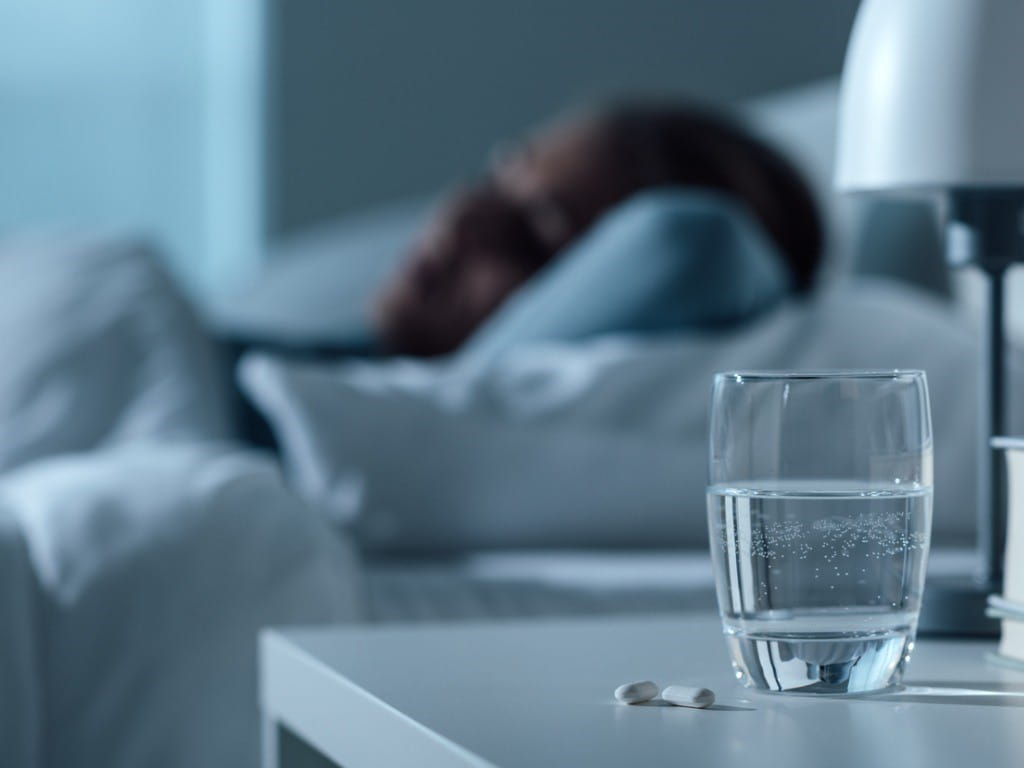Safety and Characteristics of Sleep Medications

The Bottom Line
Sleep deprivation is a common condition among US adults. Non-drug approaches should be tried first. Medicines for sleep include prescription agents, OTC drugs, and dietary supplements. Many sleep aids can cause dependence or next-day drowsiness. Dietary supplements and herbals promoted to help sleep are not approved by the FDA as safe or effective.

The Full Story
Sleep is essential for physical and mental health. A good night's sleep can start your whole day off right, yet it is sometimes elusive. In fact, about 35% of US adults say they get fewer than 7 hours of sleep a night, which puts them in the category of "sleep deprived." You can catch up by taking a cat-nap during the day, right? The fact is, you can't. And since regular sleep deprivation affects your mood and coordination, it can impair your judgment and increase the chances of accidents and falls. Over time, not getting enough sleep puts you at greater risk for serious conditions like cardiovascular disease, high blood pressure, type-2 diabetes, asthma, and depression.
It's no surprise that sleep deprivation is a major public health problem. In fact, it's a leading reason for people to seek medical care. Sleep problems take many forms, but most commonly fall into two categories: difficulty falling asleep (sleep-onset insomnia) and difficulty staying asleep (sleep-maintenance insomnia). Sometimes, a person can have both problems.
What are some treatment options for insomnia?
Even in ancient times, people looked for ways to sleep better. Fermented beverages (alcohol) and plant-based remedies such as opium were popular sedatives in the past. If you were an insomniac in the 1800s, you might have tried a patent medicine containing laudanum, which is a mixture of opium and alcohol. Laudanum was very effective at inducing sleep, but it had some drawbacks – it suppressed breathing and was habit-forming. Patent medicine labels often contained dosing instructions to treat teething in infants and young children, which resulted in many deaths. Other sedatives, such as barbiturates and chloral hydrate, came along later to replace laudanum, but they also carried high risks of drug dependence and death from overdoses. In the mid-1960s, safer sedatives began to appear.
The FDA-approved sedative medications currently in use have been developed to affect the nerve pathways concerned with sleep and waking. Naturally occurring sleep-promoting chemicals in the human nervous system include GABA (gamma-aminobutyric acid) and melatonin, while wakefulness is promoted by chemicals like orexin and histamine. Many sedative medications act by either enhancing the effects of GABA or melatonin, or by inhibiting the actions of orexin or histamine.
Cognitive behavioral therapy (CBT) is considered the most effective treatment for chronic insomnia, but a medication can be added if a person still needs extra help sleeping. Many new prescription sleep medications have become available in the past 2 decades. Other remedies for insomnia include over-the-counter (OTC) antihistamines and herbal preparations. Non-medicinal approaches referred to as "sleep hygiene" are often recommended for anyone wanting to improve their sleep quality.
|
Category/brain chemical affected |
Examples |
Effectiveness |
Comments |
|
Benzodiazepine receptor agonists (enhance GABA) |
Zolpidem (Ambien) |
Sleep-onset and sleep-maintenance insomnia |
C-IV controlled substances |
|
Benzodiazepines (enhance GABA) |
Triazolam (Halcion) Temazepam (Restoril) |
Sleep-onset and sleep-maintenance insomnia |
C-IV controlled substances Do not discontinue abruptly |
|
Melatonin receptor agonists (enhance melatonin) |
Ramelteon (Rozerem) |
Sleep-onset insomnia (modestly effective) |
|
|
Orexin receptor antagonists (block orexin) |
Suvorexant (Belsomra) |
Sleep-onset and sleep-maintenance insomnia |
C-IV controlled substance Do not exceed 20 mg |
|
Low-dose tricyclic antidepressants (block histamine) |
Doxepin (Silenor) |
Sleep-maintenance insomnia |
Anticholinergic side effects |
|
OTC antihistamines (block histamine) |
Diphenhydramine, doxylamine |
Sleep-onset and sleep-maintenance insomnia |
Rapid development of tolerance to sedative effects Anticholinergic side effects |
|
Dietary supplements |
Melatonin, valerian, tryptophan |
Sleep-onset and sleep-maintenance insomnia (weak evidence) |
Not FDA-approved for safety and effectiveness |
Sleep hygiene is a funny-sounding term that includes a lot of non-drug strategies aimed at improving sleep by helping you maintain a stable sleep schedule and establish a relaxing pre-bed routine. Things like waking up at the same time each day, limiting daytime naps, getting regular exercise, and avoiding large meals or caffeine near bedtime are some common examples of sleep hygiene. Even avoiding exposure to bright artificial light, such as from a TV or computer screen (or your cell phone!), late in the day can ease your body into getting the rest it needs by allowing melatonin to build up in your bloodstream as part of its daily cycle.
What are the adverse effects of different sleep medicines?
As an extension of their sedative effects, most sleep medications cause additional sleepiness if more than the recommended dose is taken. Symptoms such as lethargy, slurred speech, and physical incoordination can occur. More severe symptoms, like suppression of breathing and coma, can follow a large overdose or mixing sedatives with other nervous system depressants such as alcohol or opioids.
Many of the sedatives listed in the table are controlled substances, meaning that dependence can develop with regular use. To minimize the risk of withdrawal, controlled substance sedatives should not be abruptly stopped. Withdrawal can be especially dangerous with benzodiazepines. The controlled substance sedatives can also cause next-day drowsiness and impair performance of physical tasks such as walking and driving. The benzodiazepine receptor agonists, sometimes called "the Z drugs," have been reported to cause side effects such as sleepwalking, sleep-driving, and amnesia when taken in high doses or with other sedating drugs.
Sleep medicines that block histamine's effects on wakefulness (doxepin and OTC antihistamines) are not controlled substances, but they carry some special precautions. They can cause anticholinergic side effects, which include dry mouth, blurred vision, constipation, and urinary retention. These could be intensified if you are already taking something with anticholinergic effects, such as an antidepressant or medication for bipolar disorder, schizophrenia, urinary incontinence, overactive bladder, or Parkinson's disease. Sedatives in this category also are likely to cause next-day drowsiness and impairment.
Melatonin is taken to supplement the body's natural production of this chemical, which helps promote a normal sleep cycle. Melatonin that is sold as a dietary supplement, as well as the prescription melatonin enhancer ramelteon, have minimal side effects and do not cause next-day sedation. Supplement formulations of melatonin, as well as valerian, tryptophan, and others have not been approved by the FDA as safe or effective.
If someone has unintentionally taken a dose of a sleep medication, please log onto the webPOISONCONTROL® online tool for guidance or call Poison Control at 1-800-222-1222. Whether you log on or call, expert assistance is available 24 hours a day.
Leslie A. McCament-Mann, PhD, RPh
Clinical Toxicologist
Poisoned?
Call 1-800-222-1222 or
Prevention Tips
- Follow good sleep hygiene practices.
- Do not take sleeping medicine until you are ready to go to bed.
- Avoid taking sleeping medicine with other sedating medications or alcohol.
- To avoid drug interactions, be sure to mention any sleep aids you take, including OTCs and dietary supplement/herbals, to your physician and pharmacist.
- Securely store all medications up and out of the reach of children and pets.
This Really Happened
Case 1. A 14-year-old boy developed slurred speech, confusion, loss of coordination, and lethargy after taking an unknown amount of zaleplon (40 to 400 mg). His parents found him in the garage trying to fill the lawn mower with gasoline (spilling a lot on the floor) while apparently sleepwalking. His mental state returned to normal 8 hours after being admitted to a hospital, but he had amnesia for the events following his overdose (from Liskow & Pikalov, 2004).
Case 2. A 72-year-old man had Parkinson's disease (PD) for 8 years. He also had sleep apnea and insomnia. He was taking several medications for PD (levodopa, pergolide, selegiline). He was receiving CPAP (continuous positive airway pressure) for sleep apnea. He took a benzodiazepine medication for sleep and had recently started taking suvorexant. Soon after adding suvorexant, he began having nightmares and sometimes yelled out and talked while asleep. He would kick at the bedding, and he once grabbed and pulled his wife's hair. When the suvorexant was stopped, the vocalizations and abnormal behavior during sleep disappeared (from Tabata et al., 2017).
For More Information
Suni E. Sleep hygiene. Seattle: Sleep Foundation.org; 2020 Aug 14 [cited 2020 Nov 30].
References
Bollu PC, Kaur H. Sleep medicine: insomnia and sleep. Mo Med. 2019 Jan/Feb;116(1):68–75.
Drugs for chronic insomnia. Med Lett Drugs Ther. 2018 Dec 17;60(1562):201–5.
Gunja N. The clinical and forensic toxicology of Z-drugs. J Med Toxicol. 2013 Jun;9(2):155–62.
Poisoned?
Call 1-800-222-1222 or
Prevention Tips
- Follow good sleep hygiene practices.
- Do not take sleeping medicine until you are ready to go to bed.
- Avoid taking sleeping medicine with other sedating medications or alcohol.
- To avoid drug interactions, be sure to mention any sleep aids you take, including OTCs and dietary supplement/herbals, to your physician and pharmacist.
- Securely store all medications up and out of the reach of children and pets.
This Really Happened
Case 1. A 14-year-old boy developed slurred speech, confusion, loss of coordination, and lethargy after taking an unknown amount of zaleplon (40 to 400 mg). His parents found him in the garage trying to fill the lawn mower with gasoline (spilling a lot on the floor) while apparently sleepwalking. His mental state returned to normal 8 hours after being admitted to a hospital, but he had amnesia for the events following his overdose (from Liskow & Pikalov, 2004).
Case 2. A 72-year-old man had Parkinson's disease (PD) for 8 years. He also had sleep apnea and insomnia. He was taking several medications for PD (levodopa, pergolide, selegiline). He was receiving CPAP (continuous positive airway pressure) for sleep apnea. He took a benzodiazepine medication for sleep and had recently started taking suvorexant. Soon after adding suvorexant, he began having nightmares and sometimes yelled out and talked while asleep. He would kick at the bedding, and he once grabbed and pulled his wife's hair. When the suvorexant was stopped, the vocalizations and abnormal behavior during sleep disappeared (from Tabata et al., 2017).
